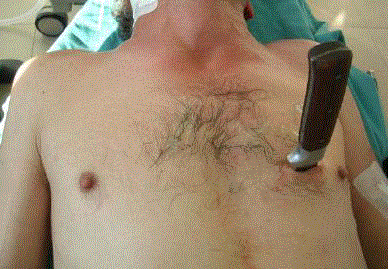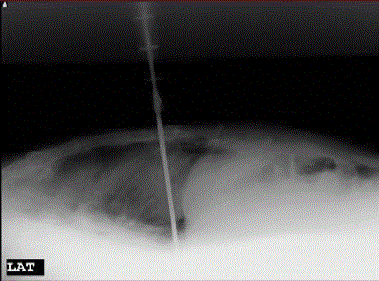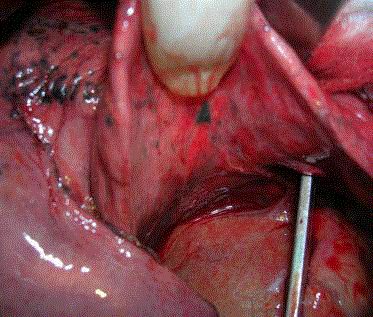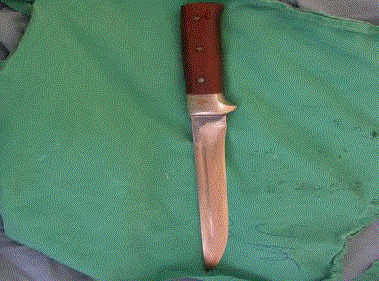Case Report
Thoracic Stab Wound: A Curious Case Report
Ivan P Novakov*
Department of Special Surgery, Medical University - Plovdiv, Bulgaria
*Corresponding author: Ivan P Novakov, Department of Special Surgery, Medical University - Plovdiv, Bulgaria
Published: 01 Nov, 2018
Cite this article as: Novakov IP. Thoracic Stab Wound: A
Curious Case Report. Clin Surg. 2018;
3: 2183.
Abstract
Self-stabbing is an uncommon method of suicide and attempt of suicide, mostly chosen by young
men and persons with a psychiatric history. A curious case of suicide attempt by self-stabbing with
a huge pointed knife in a 38-year-old male was presented. A long pointed knife was found entirely
embedded in the left hemithorax of the man, but no fatal injury occurred.
Keywords: Suicide attempt; Self-stabbing; Knife
Introduction
Suicide and suicide attempts are a major cause of death and morbidity worldwide [1,2]. Methods that are used in cases of suicide vary among populations and communities, as well as over time. Self-stabbing is an uncommon method of suicide, mostly chosen by young men and persons with a psychiatric history [2-4]. The left part of the chest (where popular knowledge believes the heart to be) represents one of the elected sites of self-inflicted wounds [3,5-7]. The aim of this case report was to present a curious non-fatal left-sided penetrating thoracic trauma, caused by impaling with a huge pointed knife as a suicide attempt.
Case Presentation
A 38-year-old male, a chronic alcoholic who committed an attempt of suicide, was presented to
the emergency department of the University Hospital “St. George”- Plovdiv. On initial presentation,
the patient was in a prone position, awake, oriented, and hemodynamically stable (blood pressure
140/90 mmHg and heart rate 92 bpm). The external examination revealed no clothing on the chest
with entirely impaled knife (just to its handle) in the left hemithorax, approximately 5 cm medially
to the left nipple (Figure 1).
Figure 1
Physical examination established respiratory rate 18 breaths per minute and slightly diminished
left breath sounds.
Lateral chest radiograph in a prone position of the patient demonstrated a knife, penetrating into
the left hemithorax (Figure 2). No evidences of pneumothorax and hemothorax and no widening of
the cardiac silhouette were established.
Figure 2
The patient was transferred from emergency department to the operating room of the
Department of Thoraco-Abdominal Surgery and left lateral thoracotomy was performed
immediately. Exploration of the thoracic cage established that the knife had passed through the
oblique fissure of the left lung, causing a small linear laceration of
outer surface of the lingula (Figure 3). The point of the knife was in a
contact with the pericardium of the left ventricle without pericardial
penetration. Approximately 100 ml of blood were aspirated from
the left costophrenic sulcus. The knife (blade with length 20 cm and
maximal width 25 mm) was removed (Figure 4). The minor lung
laceration was over sewed and the chest wall knife’s tract was sutured.
Figure 4
The patient was discharged at the 7th day after his admission,
without postoperative complications and without any pathology on
control chest radiograph.
Figure 1
Figure 2
Figure 3
Discussion
Suicide is a frequent cause of death all over the world but selfstabbing
is an uncommon method, constituting no more that 3% of
suicides. Although stab wounds of the chest are a relatively common
form of penetrating chest trauma, no more that 10.5% of them are
self-inflicted [7]. The left part of the chest where it is familiar the heart
to be represents the elected site of self-inflicted wounds in a suicide
or attempts of suicide [3,5,6]. The aim of this publican was to present
a curious case of left-sided penetrating thoracic trauma, caused by
impaling with a huge pointed knife as an attempt of suicide.
Mostly young men and persons with a psychiatric history choose
self-stabbing as a manner of suicide or attempt of suicide that was
confirmed by the presented case [2-5]. Even with no documented
psychiatric history in this 38-year-old man, chronic alcoholism could
be considered the reason of his behavior.
Three criteria are accepted as classical for self-inflicted suicide
and attempts of suicide: the presence of several self-inflicted stabs,
hesitation marks and the absence of clothing [2,3]. However, the
presented case did not resemble the classical cases. There was only
one single incision and no hesitation marks.
Knives are the most popular weapons in penetrating stab wounds
of the chest [1,8]. The force needed for a knife to penetrate the chest
depends on several factors. One of them is the sharpness of the knife.
Sharp “pointed” knife is one of the most common types of knives for
homicides and suicides, just like in the presented case [8].
Usually, in cases of stab injuries, the knives are exceptionally
found at the time when medical personnel arrive at the scene [9].
Curiously, in the presenting case the knife was found embedded into
the chest and the man himself gave explanation about his attempt of
suicide.
Extraction of embedded objects from the chest can result in
major bleeding, hemodynamic deterioration and rapid death of the
victim. That is why penetrating objects impaled in the chest are left
undisturbed, in order to be removed in the operating room under
direct vision [10-12]. There is a publication on VATS approach to
guide extraction of embedded knife from the chest [13]. However,
thoracotomy is usually used, just like in the presented case.
Another curiosity in the presented case was the track of the knife’s
blade in the thoracic cage. It passed through the oblique fissure of the
left lung along to the inter lobar segment of pulmonary artery and
lower left pulmonary vein. The point of the knife was found to be in
contact with the pericardium, but without injuring of the heart and
major blood vessels. There was no pneumothorax and only minimal
hemothorax was established.
Figure 4
Conclusion
In conclusion, this case presented a curious attempt of suicide by self-stabbing of the chest with a huge pointed knife without lifethreatening injuries.
References
- Mann JJ. A current perspective of suicide and attempted suicide. Ann Intern Med. 2002;136(4):302-311.
- Pentone A, Innamorato L, Introna F. Dying transfixing his own heart a rare case of suicide by stabbing. Am J Forensic Med Pathol. 2013;34 (4):318-20.
- Oshima T, Kondo T. Eight cases of suicide by self-cutting or -stabbing: consideration from medico-legal view points of differentiation between suicide and homicide. J Clin Forensic Med. 1997;4:127-132.
- Möller-Leimkühler AM. The gender gap in suicide and premature death or: why are men so vulnerable? Eur Arch Psychiatry Clin Neurosci. 2003;253(1):1-8.
- Karger B, Wennemann B. Suicide by more than 90 stab wounds including perforation of the skull. Int J Legal Med. 2001;115 (3):167-9.
- Edirisinghe PA, Busuttil A. Medical suicide - groin stabbing. J Clin Forensic Med. 2006;13(2):92-95.
- Furukawa H, Tsuchiya K, Ogata K, Kabuto Y, Iida Y. Penetrating knife injury to the heart. Jpn J Thorac Cardiovasc Surg. 2000;48(2):142-4.
- Gill JR, Catanese C. Sharp injury fatalities in New York City. J Forensic Sci. 2002;47(3):554-7.
- Hainsworth SV, Delaney RJ, Rutty GN. How sharp is sharp? Towards quantification of the sharpness and penetration ability of kitchen knives used in stabbing. Int J Legal Med. 2008;122(4):281-291.
- Tanel Laisaar. Unusual case of self-inflicted thoracic knife wounds with five knives embedded in the left thoracic cavity. Eur J of Cardio-Thorac Surg. 2005;28(4):653-4.
- Demetriades D, Rabinovitz B, Markides N. Indications for thoracotomy in stab injuries of the chest: a prospective study of 543 patients. Br J Surg. 1986;73(11):888-90.
- Peloponissios N, Halkic N, Moeschler O, Schnyder P, Vuilleumier H. Penetrating thoracic trauma in arrow injuries. Ann Thorac Surg. 2001;71(3):1019-21.
- Ashraf SS, Volans AP, Sharif H, Chaudhry I, Akhtar K, Siddiqi T, et al. The management of stab wounds to the chest: sixteen years’experience. J Roy Coll Surg Edinb. 1996;41(16):379-81.
- Bar I, Rivkind A, Deeb M, Simha M. Thoracoscopically guided extraction of an embedded knife from the chest. J Trauma 1998;44(1):222-3.




